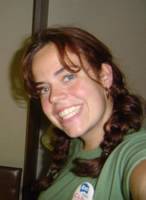Ok. 17 anos depois aconteceu outra vez
"Shuttle Columbua breaks Up over Texas"
CAPE CANAVERAL, Fla. (Feb. 1) - Space shuttle Columbia broke apart in flames over Texas on Saturday, killing all seven astronauts just 16 minutes before they were supposed to glide to ground in Florida.
''It's gone,'' said a senior U.S. official who spoke on condition of anonymity. The official said debris from the shuttle, spread across Texas and apparently some other states, had been positively identified. Though there was no official word from NASA, this official said there was no hope for either the shuttle or its crew.
Six Americans and the first Israeli astronaut were on board.
At Kennedy Space Center, the U.S. flag next to the countdown clock was lowered to half-staff. NASA officials wouldn't confirm that the crew was dead but said President Bush would be making an announcement.
Administration officials said there was no immediate indication of terrorism. A senior U.S. official, speaking on condition of anonymity, said no threat was made and the shuttle was out of range of a surface-to-air missile.
Columbia had been expected to land in Florida at 9:16 a.m.
At 9 a.m., Mission Control lost all data and contact with the crew. At the same time, residents in eastern Texas reported hearing ''a big bang.''
Television footage showed a bright light over Texas followed by smoke plumes streaking diagonally through the sky. Debris appeared to break off into separate balls of light as it continued downward. NASA declared an emergency after losing contact with the crew and sent search teams to the Dallas-Fort Worth area.
Residents of Nacogdoches, Texas, said they found bits of metal strewn across the city. Dentist Jeff Hancock said a metal bracket about a foot long crashed through his office roof.
''It's all over Nacogdoches,'' said barber shop owner James Milford. ''There are several little pieces, some parts of machinery ... there's been a lot of pieces about 3 feet wide.''
Two hours after the shuttle had been expected to land, the giant screen at the front of Mission Control showed a map of the Southwest United States and what should have been Columbia's flight path.
NASA Administrator Sean O'Keefe was meeting with the astronauts' families, who had been waiting at Kennedy Space Center for the shuttle's landing, spokeswoman Melissa Motichek said.
''A contingency for the space shuttle has been declared,'' Mission Control somberly repeated over and over as no word or any data came from Columbia.
It was the 113th flight in the shuttle program's 22 years and the 28th flight for Columbia, NASA's oldest shuttle.
In 42 years of U.S. human space flight, there had never been an accident during the descent to Earth or landing. On Jan. 28, 1986, space shuttle Challenger exploded shortly after liftoff.
The shuttle is essentially a glider during the hour-long decent from orbit and is covered by about 20,000 thermal tiles to protect against temperatures as high as 3,000 degrees.
On Jan. 16, shortly after Columbia lifted off, a piece of insulating foam on its external fuel tank came off and was believed to have hit the left wing of the shuttle. Leroy Cain, the lead flight director in Mission Control, assured reporters Friday that engineers had concluded that any damage to the wing was considered minor and posed no safety hazard.
The shuttle was at an altitude of about 203,000 feet over north-central Texas at 9 a.m., traveling at 12,500 mph, when Mission Control lost all contact and tracking data.
Gary Hunziker in Plano, Texas, said he saw the shuttle flying overhead. ''I could see two bright objects flying off each side of it,'' he told The Associated Press. ''I just assumed they were chase jets.''
''The barn started shaking and we ran out and started looking around,'' said Benjamin Laster of Kemp, Texas. ''I saw a puff of vapor and smoke and saw big chunk of material fall.''
Former astronaut John Glenn and his wife were watching on television at their home in Maryland.
''Anytime you lose contact like that, there's some big problem. Of course, once you went for several minutes without any contact, you knew something was terribly wrong,'' Glenn said.
Security had been extraordinarily tight for Columbia's 16-day scientific research mission because of the presence of Ilan Ramon, the first Israeli astronaut.
Ramon, 48, a colonel in Israel's air force and former fighter pilot, had survived two wars. He became the first man from his country to fly in space, and his presence resulted in an increase in security, not only for Columbia's launch, but also for its planned landing. Space agency officials feared his presence might make the shuttle more of a terrorist target.
''The government of Israel and the people of Israel are praying together with the entire world for the safety of the astronauts on the shuttle Columbia,'' Prime Minister Ariel Sharon's office said in a statement.
Columbia's crew had completed 80-plus scientific research experiments during their time in orbit.
Only three of the seven astronauts had flown in space before, the shuttle's commander, Rick Husband, Michael Anderson, and Kalpana Chawla. The other four were rookies: pilot William McCool, David Brown, Laurel Clark and Ramon.
Just in the past week, NASA observed the anniversary of its only two other space tragedies, the Challenger explosion, which killed all seven astronauts on board, and the Apollo spacecraft fire that killed three on Jan. 27, 1967.
Copyright 2003 The Associated Press. The information contained in the AP news report may not be published, broadcast, rewritten or otherwise distributed without the prior written authority of The Associated Press. All active hyperlinks have been inserted by AOL.
Miami Connection
Aqui estou eu uma brasileira em Miami,e acredito que é preciso manter as raízes!!


0 Comments:
Postar um comentário
<< Home